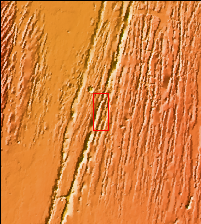
Context imageThis VIS image shows part of Tractus Catena, just one of many north/south trending tectonic graben located south and east of Alba Mons. The graben with circular pits are part of Tractus Catena. The graben without pits are part of Tractus Fossae. The pits most likely formed as a result of roof collapse into an underlying open space such as a lava tube.
Graben are formed by extension of the crust and faulting. When large amounts of pressure or tension are applied to rocks on timescales that are fast enough that the rock cannot respond by deforming, the rock breaks along faults. In the case of a graben, two parallel faults are formed by extension of the crust and the rock in between the faults drops downward into the space created by the extension. Numerous sets of graben are visible in this THEMIS image, trending generally north/south. Because the faults defining the graben are formed perpendicular to the direction of the applied stress, we know that extensional forces were pulling the crust apart in the east/west direction. The large number of graben around Alba Mons is generally believed to be the result of extensional forces associated with the uplift of the volcano.
Orbit Number: 94890 Latitude: 25.2421 Longitude: 256.932 Instrument: VIS Captured: 2023-05-06 13:14
Please see the THEMIS Data Citation Note for details on crediting THEMIS images.
NASA's Jet Propulsion Laboratory manages the 2001 Mars Odyssey mission for NASA's Science Mission Directorate, Washington, D.C. The Thermal Emission Imaging System (THEMIS) was developed by Arizona State University, Tempe, in collaboration with Raytheon Santa Barbara Remote Sensing. The THEMIS investigation is led by Dr. Philip Christensen at Arizona State University. Lockheed Martin Astronautics, Denver, is the prime contractor for the Odyssey project, and developed and built the orbiter. Mission operations are conducted jointly from Lockheed Martin and from JPL, a division of the California Institute of Technology in Pasadena.

